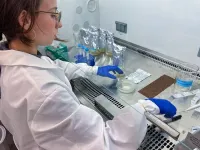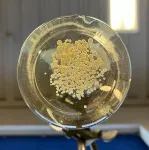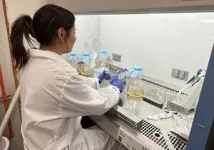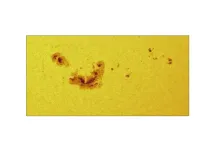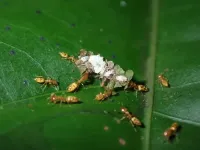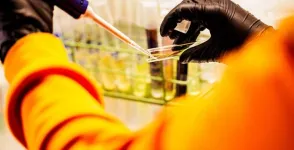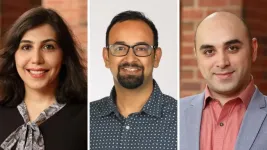(Press-News.org) URBANA, Ill. – Creating fertilizers from organic waste can help reduce the consumption of fossil fuels and promote sustainable production. One way of doing this is through hydrothermal liquefaction (HTL), which converts biomass into biocrude oil through a high-temperature, high-pressure process. Two studies from the University of Illinois Urbana-Champaign explore the use of a fungal treatment to convert the leftover wastewater into fertilizer for agricultural crops.
“HTL uses wet biomass from organic sources such as swine manure or food waste. The process yields wastewater, called hydrothermal liquefaction aqueous phase (HTL-AP), which is usually discarded. We know it contains nutrients that can be used for fertilizer, but they are mostly in organic forms that plants can't access. HTL-AP may also contain toxic heavy metals, depending on the type of biowaste,” said co-author Paul Davidson, an associate professor in the Department of Agricultural and Biological Engineering (ABE), part of the College of Agricultural, Consumer and Environmental Sciences and The Grainger College of Engineering at Illinois.
“We explored the use of Trametes versicolor, a white-rot fungus, to break the organic nitrogen compounds into ammonia or nitrate and potentially remove toxic components. As an eco-friendly approach, T. versicolor has been explored to treat different wastewater and seems a promising candidate to treat HTL-AP,” said Vitória Leme, lead author of the first study.
Leme, then a master’s student in ABE, developed the methods to grow the fungus and add it to the wastewater. This study demonstrated that treating a solution containing 5 % HTL-AP with T. versicolor for 3 days increased nitrate and ammonia concentrations significantly.
After Leme graduated, Karla Lopez took over. She conducted the research as an undergraduate student in Engineering Technology and Management for Agricultural Systems (ETMAS), one of two undergraduate degree paths housed in ABE.
Lopez was the lead author of the second study combining the fungal treatment with a bacterial nitrification process to further convert ammonia into nitrate. The study found that simultaneous inoculation of T. versicolor and nitrifying bacteria increased nitrate concentrations in HTL-AP 17 times.
“We looked at different factors that affected the results and found the samples had the highest increases in both nitrate and ammonia when the microorganisms were subjected to water with a pH range of 6 to 7.5,” Lopez stated. “There's also evidence that the fungus is removing some of the potentially toxic compounds in the biowaste. We found the treatment produced an enzyme that has been shown to degrade toxins.”
Building on the promising results from the two studies, Davidson’s research team is now working on using the treated wastewater to grow hydroponic crops.
He said the treatment should ideally be done as close as possible to the HTL process, establishing a circular economy and reducing the need to transport heavy, wet biomass long distances.
“For example, if you are using swine manure as your wet feedstock, you could set up this whole system in close proximity to a swine farm, where there are thousands of pigs and lots of manure. You can collect the manure and run it through the HTL process, extract the wastewater, and have a separate system set up to treat the wastewater onsite. And if you’re near a swine farm, there’s probably crops nearby where you can use the treated wastewater as a fertilizer.”
The first study, “Hydrothermal liquefaction aqueous phase mycoremediation to increase inorganic nitrogen availability,” is published in Heliyon [https://doi.org/10.1016/j.heliyon.2024.e31992]. Authors are Vitoria Leme, Karla Lopez, Tiago Costa, Beth Conerty, Laurie B. Leonelli, Yuanhui Zhang, and Paul Davidson. This work was supported by the USDA National Institute of Food and Agriculture, Hatch project 1021253.
The second study, “Wastewater Nutrient Recovery via Fungal and Nitrifying Bacteria Treatment,” is published in Agriculture [https://doi.org/10.3390/agriculture14040580]. Authors include Karla Lopez, Vitoria Leme, Marcin Warzecha, and Paul Davidson. This work was partially funded by the USDA National Institute of Food and Agriculture, Hatch project 1021253.
END
Illinois studies explore converting wastewater to fertilizer with fungal treatment
2024-07-19
ELSE PRESS RELEASES FROM THIS DATE:
Time-lapse imaging for embryo selection in IVF does not improve the odds of live birth compared with conventional methods, according to largest study of its kind
2024-07-19
There is no difference in live birth rates between time-lapse imaging and other standard approaches used in in-vitro fertilisation (IVF) for embryo incubation and selection prior to implantation, according to the results of the largest trial of its kind.
The randomised controlled trial looked at IVF outcomes in the UK and Hong Kong. The results, published today in The Lancet, provide much-needed evidence that using time-lapse imaging (TLI) does not improve treatment outcomes for someone undergoing fertility treatment.
Time-lapse imaging is a technique ...
Early riser! The Sun is already starting its next solar cycle – despite being halfway through its current one
2024-07-19
Early riser! The Sun is already starting its next solar cycle – despite being halfway through its current one
Royal Astronomical Society press release
RAS PR 24/21 (NAM 7)
Embargoed until 00:01 BST on Friday 19 July 2024
The first rumblings of the Sun's next 11-year solar cycle have been detected in sound waves inside our home star – even though it is only halfway through its current one.
This existing cycle is now at its peak, or 'solar maximum' - which is when the Sun’s magnetic field flips and its poles swap places - until mid-2025.
It affects ...
Oakland hospital building is approved for construction
2024-07-19
Subscribe to UCSF News
Note to Editors: Photos and renderings are available in our Media Kit
UC Regents sign off on $1.5 billion project to construct a new hospital building at UCSF Benioff Children’s Hospital Oakland, securing the future of world-class pediatric facilities in the East Bay.
UCSF Benioff Children’s Hospitals has received final approval on a $1.49 billion hospital building on its Oakland campus that will provide a state-of-the-art, child-centered medical facility for families across the Bay Area. The proposal was approved ...
Rice’s Emilia Morosan awarded prestigious Vannevar Bush Faculty Fellowship
2024-07-18
Rice University’s Emilia Morosan has been selected as one of 11 scientists and engineers for the 2024 Vannevar Bush Faculty Fellowship (VBFF) to support her work on correlated topological materials. The fellowship is the Department of Defense’s (DoD) most prestigious single-investigator award and supports groundbreaking basic research with the potential to transform various fields.
The VBFF, a five-year fellowship with up to $3 million in funding, encourages innovative ideas where researcher creativity intersects with the unknown. Vannevar Bush Fellows represent a cadre of experts who provide invaluable direction to the DoD ...
DOE announces $52 million for small business research and development grants
2024-07-18
WASHINGTON, D.C.—In support of President Biden’s Investing in America agenda, the U.S. Department of Energy (DOE) today announced awards totaling $52 million for a broad range of small businesses in 39 states. The projects will work to solve a wide range of problems—from cybersecurity for electric vehicle charging infrastructure to new ways to detect radiation threats and new ways to manufacture lithium metal for batteries.
“Since Day One, the Biden-Harris Administration has supported small businesses, prompting record ...
Of ants and trees: ‘Evolutionary déjà’ in the tropical rainforest
2024-07-18
Ants are famous for their regimented and complex social behaviors. In the tropics, they are also famous for forming mutualisms with plants. Certain species of trees have conspicuous hollow swellings that house ants, often feeding the ants with specialized ant food. In return, the ants are pugnacious bodyguards, swarming out to aggressively defend the plant against enemies. Scientists have observed these mutualisms for centuries, but an enduring question is how these intriguing interactions evolved in the first place.
That remains a mystery, but new research led by University ...
Tumor-infiltrating lymphocyte therapy marks a milestone in cancer treatment
2024-07-18
TAMPA, Fla. — The recent U.S. Food and Drug Administration approval of lifileucel, the first commercial tumor-infiltrating lymphocyte (TIL) therapy for advanced melanoma, marks a significant breakthrough in cancer therapy. In a new commentary published in Cancer Cell, Moffitt Cancer Center scientists provide a comprehensive overview of the therapy’s development and highlight its transformative potential.
“TIL therapy represents a major advancement in personalized cancer treatment, offering new possibilities for patients with treatment-resistant cancers,” said Amod Sarnaik, M.D., ...
New research on climate change, gut health, and socioeconomic status’ impact on stroke and aneurysm care to be presented at Society of Neurointerventional Surgery’s 21st Annual Meeting
2024-07-18
FOR IMMEDIATE RELEASE: July 18, 2024
CONTACT: Camille Jewell, cjewell@vancomm.com or 202-248-5460
COLORADO SPRINGS, Colo. — Neurointerventional surgeons from across the globe will gather at the Society of NeuroInterventional Surgery’s (SNIS) 21st Annual Meeting from July 22 through July 25 in Colorado Springs, Colorado, to present novel research and innovation in their field.
The conference, held at the Broadmoor Resort, will be a hybrid event with in-person and livestreamed content. Meeting sessions will cover new topics ranging from how living in coal mining areas worsens outcomes ...
Statewide Biomedical and Clinical Research Collaborative Awards granted
2024-07-18
Researchers from the University of Tennessee Health Science Center College of Medicine-Knoxville; the University of Tennessee, Knoxville; and the University of Tennessee Health Science Center Office of Research understand the challenges affecting the health and wellness of Tennesseans. A new system-wide collaborative grant program led by UTHSC COM-K is supporting research and scholarly activities to pursue discoveries addressing health issues across Tennessee and beyond.
The program will fund six awards totaling more than $450,000 to support teams of clinicians, faculty, and researchers from across the state to innovate in the field of medicine and biomedical research.
Robert ...
First-ever hurricane evacuation order database may hold keys to future readiness
2024-07-18
A team of University of Virginia researchers released the first-ever database of hurricane evacuation orders in the United States. By examining what has worked (and hasn’t) in the face of oncoming hurricanes, leaders and government officials can increase community resilience, create better policy and, ultimately, reduce loss of life.
The project, seed-funded by UVA’s Environmental Institute, teamed Majid Shafiee-Jood and Negin Alemazkoor and Harsh Anand, an engineering doctoral candidate, from the School of Engineering and Applied Science. The trio spent countless hours gathering all nationwide public-facing evacuation orders and created a database that can ...
